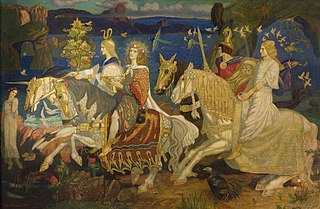Folktale

In folklore collected during the 19th century, Balor is a warrior or tyrant who is generally said to live on Tory Island. [21] [e] Balor hears a prophecy that he would be killed by his grandson. To avoid his fate, he locks his only daughter, Ethnea (Eithne), in a tower to keep her from becoming pregnant. Balor goes to the mainland and steals the magical cow of abundance Glas Gaibhnenn belonging to MacKineely (Cian mac Cáinte) [23] [24] [f] MacKineely/Cian learns he can only get the cow back when Balor is dead, and with the help of his female familiar spirit ( leanan sídhe ) named Biróg, enters the tower, finds Ethnea and impregnates her. When she gives birth to three sons, Balor orders the three to be drowned, but one survives without Balor's knowledge. The grandson is fostered by the smith who is his uncle [g] Balor eventually encounters his grandson by chance and is killed by him. [21]
The unnamed grandson in the tale is recognizable as Lugh. In "Balor on Tory Island" and its variant, the child is called Lughaidh Lámhfhada (Lughaidh Longhand), [26] [27] and is recognized as an equivalent of Lugh. [28] In the very similar Irish text "Balor agus Mac Cionnfhaolaidh", [h] [29] the child is Lugh Fadlámhach, i.e., "Lugh the long-armed". [30] In another variant, the child is called Dul Dauna, [25] which has been explained as a corruption of Ildanach "master of all knowledge", Lugh's nickname. [31]
The weapon used against Balor by his grandson may be a red-hot heated iron rod, [21] or a special red spear crafted by the smith Gaivnin Gow, [26] the latter being of special interest to A. C. L. Brown who tries to establish connection to Arthurian lore. [28]
Balor's eye
"Balor himself may have one, two or three eyes, one of which is poisonous, incendiary, or otherwise malignant; he may have two eyes in front, one each in front and back, an extra eye in the middle of his forehead. Lugh always puts the evil eye out", as summarized by Mark Scowcroft. [32]
In O'Donovan's version of the folktale above, Balor has one eye in the middle of the forehead, and a deadly eye on the back of his head. It is described as both venomous, and issuing some sort of petrifying beam with powers like unto a basilisk. [33] [34] O'Curry deplored the dissemination of such a "peasantry" version, assisted by O'Donovan printing it. [20] This second eye in the back does not preclude comparison with the one-eyed Cyclops of Greek myth. [35]
In "Balor on Tory Island", Balor covers the eye in the middle of his forehead with nine leather shields, but Lugh (Lui Lavada "the Longhand") sends a red spear crafted by Gavidin Gow through all the layers. [26] [i]
It may be that this forehead eye should be interpreted as an "extra eye in the middle of his forehead" (one of three) as Scowcroft puts it, otherwise Balor would be rendered blind most of the time. But Scowcroft does not specify the work to which he is alluding. Balor is explicitly three-eyed in a version published by William Hamilton Maxwell. [37]
But another version of the folktale (from County Mayo) says that Balor was one-eyed, yet it was usually covered: "He had a single eye in his forehead, a venomous fiery eye. There were always seven coverings over this eye. One by one Balar removed the coverings. With the first covering the bracken began to wither, with the second the grass became copper-coloured, with the third the woods and timber began to heat, with the fourth smoke came from the trees, with the fifth everything grew red, with the sixth it sparked. With the seventh, they were all set on fire, and the whole countryside was ablaze!" [2]
Severed head and lake origin tales
According to a lay in Duanaire Finn , after he was slain, Balor's severed head was set in the fork of an oak, and the tree which absorbed the venom became the timber-wood made into the shield of Fionn mac Cumhaill. [38]
In "Balor on Tory Island" and the Irish text close to it, Lui Lavada (or Lugh) sets Balor's head on a rock, and a lake forms from the dripping pool of liquid. The Irish text does not specify location, but Curtin's tale in English names Gweedore Loch (in County Donegal, local to the storyteller). [26] [29]
According to folklore from County Sligo, Balor was said to have a glass through which he would look to destroy a person with his eye. He used the glass to burn and wither all of the plants at Moytura, which prompted a hero to ask how he did this. Balor, being duped by the trick, removed the glass from his eye long enough for the hero to put the eye out. The blood running from Balor's eye [j] created a lake called Suil Balra or Lochan na Súil (Lough Nasool, "lake of the eye"), [39] near Ballindoon Abbey. [40]
Localization of the legend
The placing of Balor's stronghold on Tory Island derives from the medieval literature, which places the Fomorians' stronghold there. [2] On Tory Island there are geological features called Dún Bhalair ("Balor's fortress") and Túr Bhalair ("Balor's tower"), [2] and a tall rock formation called Tór Mór ("great tower"). [41]
Although the Tory Island version of the folktale printed by O'Donovan was influential, this may have misled the public with the impression that "Tory has almost a monopoly of Balor traditions", so argues Henry Morris. [22] O'Donovan said that Balor was remembered "throughout Ireland". [7] The Balor tales involving the magic cow were also being told plentifully elsewhere, particularly "South of Ulster". Morris stated he had collected "remnants" in Farney, Monaghan c. 1900, and that these versions connected Balor and the cow Glasgaivlen with places as far afield as "south Monaghan to Rockabill Island off the coast of Dublin". [22] [k]










